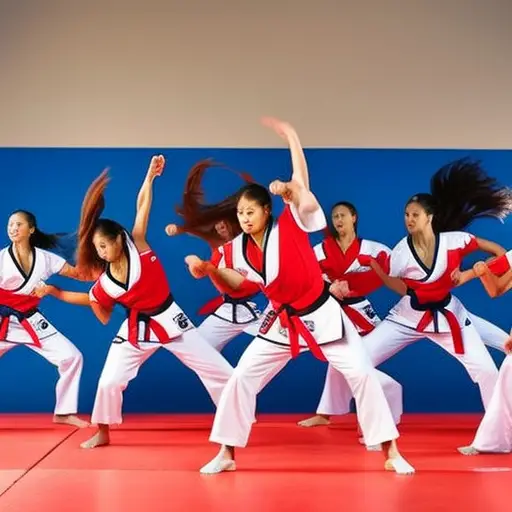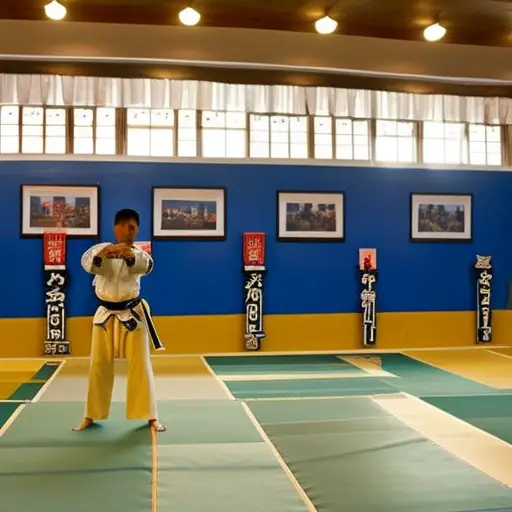Exploring the Future of Taekwondo

As the world of martial arts continues to evolve, the future of taekwondo holds exciting possibilities.
In this article, we will delve into the advancements in training technology, the evolution of techniques and tactics, and the impact of combat sports on the future of taekwondo.
Moreover, we will explore the potential for new and innovative competitions, and the necessity for adapting taekwondo to meet the changing demands of modern society.
Join us on this journey of discovery as we navigate the future of taekwondo.
Technological Innovations in Taekwondo Training
The integration of virtual reality technology has revolutionized taekwondo training, enhancing athletes’ skills and performance. Virtual reality training has provided a new dimension to traditional training methods by creating an immersive and interactive environment for athletes to practice and refine their techniques. By using virtual reality headsets, athletes can simulate various scenarios and opponents, allowing for a more realistic and dynamic training experience.
One of the key advantages of virtual reality training in taekwondo is the ability to provide instant feedback and analysis. Wearable technology, such as motion sensors and haptic feedback devices, can be integrated into the virtual reality system to track and analyze an athlete’s movements in real-time. This allows athletes to receive immediate feedback on their technique, posture, and timing, enabling them to make necessary adjustments and improvements.
Furthermore, virtual reality training can also help athletes overcome mental barriers and enhance their mental resilience. By simulating high-pressure situations and challenging opponents, athletes can develop the mental fortitude and focus required to perform at their best during competitions.
The combination of virtual reality technology and wearable devices has opened up new possibilities for taekwondo training, offering athletes a more engaging and effective way to improve their skills and performance. As the technology continues to advance, we can expect further innovations and advancements in virtual reality training for taekwondo and other sports.
Evolution of Taekwondo Techniques and Tactics
Several advancements in technology and training methods, coupled with the integration of strategic analysis, have propelled the evolution of taekwondo techniques and tactics. This constant evolution is driven by the desire to improve performance and adapt to changing circumstances.
Here are some key developments in the evolution of taekwondo techniques and tactics:
-
Adoption of electronic scoring systems: The introduction of electronic scoring systems has revolutionized taekwondo sparring. These systems provide instant feedback and accuracy in scoring, enhancing the precision and fairness of competitions.
-
Incorporation of multidisciplinary training: Taekwondo practitioners now recognize the importance of cross-training in various martial arts and sports. By integrating techniques from other disciplines such as boxing, kickboxing, and wrestling, practitioners can expand their skill set and develop a more well-rounded approach to combat.
-
Strategic emphasis on distance management: Modern taekwondo places a significant emphasis on controlling distance during sparring. Practitioners focus on maintaining the optimal range to execute their techniques effectively while minimizing the risk of counterattacks.
These advancements in taekwondo techniques and tactics reflect the sport’s ongoing evolution. By embracing new technologies, interdisciplinary training, and strategic approaches, taekwondo continues to evolve into a more dynamic and effective martial art.
The Impact of Combat Sports on the Future of Taekwondo
With the growing popularity of combat sports worldwide, the future of taekwondo is shaped by the influence and integration of these disciplines. Combat sports, such as mixed martial arts and kickboxing, have gained significant traction in recent years, captivating audiences with their intense and dynamic nature. As a result, taekwondo has started to incorporate elements from these combat sports to stay relevant and evolve with the changing times.
One of the key impacts of combat sports on the future of taekwondo is the inclusion of women. Historically, taekwondo has been dominated by male athletes, but combat sports have paved the way for women to participate and excel in martial arts. The success of female fighters in combat sports has inspired more women to take up taekwondo, leading to greater gender equality in the sport.
Furthermore, combat sports have facilitated cultural exchange within the taekwondo community. As practitioners from different martial arts backgrounds come together, they bring with them unique techniques, training methods, and philosophies. This exchange of knowledge and experiences enriches taekwondo, allowing it to expand its repertoire and become more diverse.
In conclusion, combat sports have brought about significant changes in taekwondo, including the inclusion of women and the promotion of cultural exchange. These developments ensure that taekwondo remains a relevant and evolving martial art.
Now, let’s delve into exploring new possibilities in taekwondo competitions.
Exploring New Possibilities in Taekwondo Competitions
Taekwondo competitions offer numerous opportunities for innovation and growth, as well as a chance to push the boundaries of traditional martial arts. As the world of technology continues to advance, there are exciting new possibilities emerging in the realm of taekwondo competitions.
One such possibility is the integration of virtual reality training, which allows athletes to immerse themselves in a realistic training environment without the limitations of physical space. This technology can enhance an athlete’s reaction time, agility, and overall performance.
Additionally, the integration of taekwondo with other martial arts has the potential to create unique and dynamic competitions. Combining the high kicks and fast-paced movements of taekwondo with the grappling techniques of Brazilian Jiu-Jitsu, for example, could lead to a captivating display of skill and strategy. It could also provide athletes with a more well-rounded training experience, as they learn to adapt their techniques to different styles of combat.
Moreover, incorporating elements of freestyle and creative forms into taekwondo competitions can further stimulate innovation. This would allow athletes to showcase their creativity and individuality, while still adhering to the core principles of taekwondo.
Adapting Taekwondo to the Changing Demands of Modern Society
As society evolves and becomes increasingly fast-paced and technology-driven, there is a growing need to adapt taekwondo in order to meet the changing demands and expectations of modern practitioners and enthusiasts alike. One of the ways taekwondo can be adapted to the changing demands of modern society is through the incorporation of virtual training.
With advancements in technology, virtual training platforms have become increasingly accessible and provide opportunities for practitioners to train at their own convenience, regardless of their location. Adapting taekwondo to virtual training allows practitioners to continue their training even when they are unable to attend physical classes.
Another aspect to consider when adapting taekwondo to the changing demands of modern society is its role in self-defense. In today’s world, personal safety and self-defense have become significant concerns for individuals. Taekwondo, with its focus on striking techniques and effective self-defense strategies, can play a vital role in equipping individuals with the necessary skills and confidence to protect themselves in real-life situations.
By emphasizing self-defense training and incorporating realistic scenarios into taekwondo practice, practitioners can better prepare themselves for potential threats in the modern world. In conclusion, as society continues to evolve, it is crucial for taekwondo to adapt to the changing demands and expectations of modern practitioners and enthusiasts.
This can be achieved through the incorporation of virtual training platforms and a greater emphasis on self-defense training. By embracing these changes, taekwondo can continue to thrive and remain relevant in the fast-paced and technology-driven world we live in.
Frequently Asked Questions
How Does Technology Impact the Mental Aspect of Taekwondo Training?
Technology has a significant impact on the mental aspect of taekwondo training. With the advancements in virtual reality and biofeedback systems, athletes can now enhance their mental resilience and focus, leading to improved performance and overall well-being.
What Are Some Historical Factors That Have Influenced the Evolution of Taekwondo Techniques and Tactics?
Historical influences and cultural impact have played a significant role in the evolution of taekwondo techniques and tactics. By examining the past, we can understand how various factors have shaped this martial art into what it is today.
How Does the Rise of Mixed Martial Arts (Mma) Affect the Future of Taekwondo as a Combat Sport?
The rise of mixed martial arts (MMA) has a significant influence on the future of taekwondo as a combat sport. This influence can be seen in the evolution of techniques, training methods, and the strategic approach to competition.
What New Possibilities Are Being Explored to Enhance the Spectator Experience in Taekwondo Competitions?
New possibilities are being explored to enhance the spectator experience in taekwondo competitions. Virtual reality experiences and interactive scoring systems are among the innovations being considered to create a more engaging and immersive viewing experience for fans.
How Can Taekwondo Adapt to Address the Increasing Need for Self-Defense in Modern Society?
Taekwondo can adapt to address the increasing need for self-defense in modern society by focusing on women empowerment and self-confidence. By incorporating training programs that emphasize practical self-defense techniques, Taekwondo can equip individuals with the skills they need to feel safe and secure.
Conclusion
In conclusion, the future of taekwondo holds promising advancements fueled by technological innovations, evolving techniques and tactics, and the impact of combat sports.
As we explore new possibilities in competitions and adapt to the changing demands of modern society, taekwondo continues to evolve as a dynamic martial art.
With knowledgeable precision and experience, we can envision a world where taekwondo thrives, captivating the audience’s imagination with its graceful yet powerful movements, creating a vivid tapestry of iron-willed warriors.





